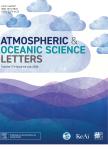Assessing the Quality of Regional Ocean Reanalysis Data from ENSO Signals
Assessing the Quality of Regional Ocean Reanalysis Data from ENSO Signals作者机构:State Key Laboratory of Numerical Modeling for Atmospheric Sciences and Geophysical Fluid Dynamics (LASG) Institute of Atmospheric Physics Chinese Academy of Sciences Beijing 100029 China Graduate University of the Chinese Academy of Sciences Beijing 100029 China
出 版 物:《Atmospheric and Oceanic Science Letters》 (大气和海洋科学快报(英文版))
年 卷 期:2012年第5卷第1期
页 面:55-61页
学科分类:0710[理学-生物学] 0908[农学-水产] 07[理学] 0707[理学-海洋科学] 070601[理学-气象学] 0706[理学-大气科学] 0816[工学-测绘科学与技术] 0825[工学-航空宇航科学与技术]
基 金:supported by the Knowledge Innovation Program of the Chinese Academy of Sciences (Grant No. KZCX2-YW-Q11-04) the Public Science and Technology Research Funds Projects of Ocean (Grant No. 201105019-3) the National Basic Research Program of China (Grant No. 2010CB951904)
主 题:reanalysis data ENSO ocean assimilation AIPO data
摘 要:The quality of regional ocean reanalysis data for "the joining area of Asia and the Indian-Pacific Ocean (AIPO)" has been assessed from the perspective of ENSO-related ocean signals. The results derived from the AIPO reanalysis, including SST, sea surface height (SSH), and subsurface ocean temperature and currents, are compared with those of Hadley Center Sea Ice and Sea Surface Temperature (HadlSST) data set and Simple Ocean Data Assimilation (SODA) reanalysis data. Both the spatial pattern and the characteristics of evolution of the ENSO-related ocean temperature anomalies are well reproduced by the AIPO reanalysis data. The physical processes proposed to explain the life cycle of ENSO, including the delayed oscillator mechanism, recharge-discharge mechanism, and the zonal advection feedback, are reasonably represented in this dataset. However, the westward Rossby wave signal in 1992 is not obvious in the AIPO data, and the magnitude of the heat content anomalies is different from that of the SODA data. The reason for the discrepancies may lie in the different mod- els and methods for data assimilation and differences in wind stress forcing. The results demonstrate the high reliability of the AIPO reanalysis data in describing ENSO signals, implying its potential application value in ENSO- related studies.



